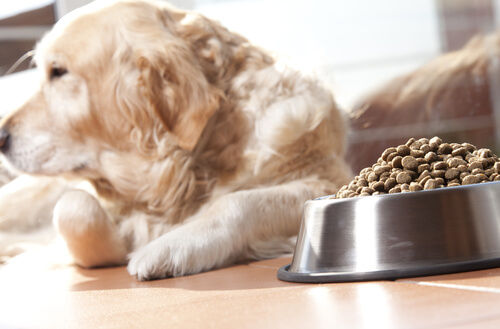Sensory Perception: A Dog's Notion of Time

They say that a dog is just as happy when you come back home no matter if you’ve been gone five minutes or three days. This is attributed to the rumor that our furry friends have no notion of time. Now, is there any truth to that? How do dogs measure time?
This topic is actually very interesting, and therefore we thought that we should take some time to talk about it.
How dogs measure time
We can measure time thanks to the clocks and watches that we have. Many people will say that they could guess what time it is, even without having a clock or watch. But, this happens because we have had clocks before and we are capable of associating the daylight with the approximate hour that we know that it was.
However, dogs go beyond that. They measure time by circadian rhythm and sensory perception. We are going to analyze both of them.
The notion of time by circadian rhythms

To start off this topic, the first thing that you should know is what circadian rhythms are. All the instinctive impulses that dogs have, whether it be eating, drinking, mating or playing, are marked by these rhythms.
These rhythms are strongly related with the rotation cycles and the revolution of the Earth, so they are the processes that mark the light and darkness throughout the day. Therefore, the animal’s biological clock is associated with these cycles, perceiving light and darkness and coming to understand what time of the day is at each moment.
For example, between 6 pm and 6 am, the animal is able to recognize that the following body changes happen :
- 6:30 pm- Maximum blood pressure
- 7 pm- Highest body temperature
- 9 pm- Melatonin secretion
- 10:30 pm- Goodbye to intestinal movements
- 2 am- Very deep sleep
- 4:30 am- Lowest body temperature
Between 6 am and 6 pm, the following changes happen:
- 6:45 am- Blood pressure rises
- 7:30 am- Body stops secreting melatonin
- 8:30 am- Intestinal movements
- 10 am- Alert status
- 2:30 pm- Good coordination
- 5:30 pm- Muscular efficiency
Circadian rhythms allow your dog to know what time of the day it is. You should respect them when educating him, training him, or when he is competing. This way, it will help him achieve the maximum physical and mental performance without hurting the animal at all.
The notion of time: sensory perception

Just like we can feel that time is passing by using our senses, dogs can perceive time by using theirs.
For example, even if their vision was only in black and white, they can deduce the quantity of light that enters through the windows and know if it’s the time when you come home.
Smell is another sense that plays a fundamental role in a dog’s notion of time. When you go far away from home, your smell diminishes, so your dog knows that you’ve already left. But when you get closer, he is capable of smelling you from meters away, and therefore he memorizes that moment and recognizes it as your arrival time everyday. Smell is the canine sense that is most related to memory.
So to sum up, the notion of time in dogs has to do with his instincts. They can associate the circumstances that surround them with the moment that they find themselves in. Therefore, a dog is not as happy if you’ve been gone five minutes or if you’ve been gone three days. Even though they don’t have a clock or watch, they recognize that the cycles that we talked about have occurred many times when you’ve been absent for a long time.
They say that a dog is just as happy when you come back home no matter if you’ve been gone five minutes or three days. This is attributed to the rumor that our furry friends have no notion of time. Now, is there any truth to that? How do dogs measure time?
This topic is actually very interesting, and therefore we thought that we should take some time to talk about it.
How dogs measure time
We can measure time thanks to the clocks and watches that we have. Many people will say that they could guess what time it is, even without having a clock or watch. But, this happens because we have had clocks before and we are capable of associating the daylight with the approximate hour that we know that it was.
However, dogs go beyond that. They measure time by circadian rhythm and sensory perception. We are going to analyze both of them.
The notion of time by circadian rhythms

To start off this topic, the first thing that you should know is what circadian rhythms are. All the instinctive impulses that dogs have, whether it be eating, drinking, mating or playing, are marked by these rhythms.
These rhythms are strongly related with the rotation cycles and the revolution of the Earth, so they are the processes that mark the light and darkness throughout the day. Therefore, the animal’s biological clock is associated with these cycles, perceiving light and darkness and coming to understand what time of the day is at each moment.
For example, between 6 pm and 6 am, the animal is able to recognize that the following body changes happen :
- 6:30 pm- Maximum blood pressure
- 7 pm- Highest body temperature
- 9 pm- Melatonin secretion
- 10:30 pm- Goodbye to intestinal movements
- 2 am- Very deep sleep
- 4:30 am- Lowest body temperature
Between 6 am and 6 pm, the following changes happen:
- 6:45 am- Blood pressure rises
- 7:30 am- Body stops secreting melatonin
- 8:30 am- Intestinal movements
- 10 am- Alert status
- 2:30 pm- Good coordination
- 5:30 pm- Muscular efficiency
Circadian rhythms allow your dog to know what time of the day it is. You should respect them when educating him, training him, or when he is competing. This way, it will help him achieve the maximum physical and mental performance without hurting the animal at all.
The notion of time: sensory perception

Just like we can feel that time is passing by using our senses, dogs can perceive time by using theirs.
For example, even if their vision was only in black and white, they can deduce the quantity of light that enters through the windows and know if it’s the time when you come home.
Smell is another sense that plays a fundamental role in a dog’s notion of time. When you go far away from home, your smell diminishes, so your dog knows that you’ve already left. But when you get closer, he is capable of smelling you from meters away, and therefore he memorizes that moment and recognizes it as your arrival time everyday. Smell is the canine sense that is most related to memory.
So to sum up, the notion of time in dogs has to do with his instincts. They can associate the circumstances that surround them with the moment that they find themselves in. Therefore, a dog is not as happy if you’ve been gone five minutes or if you’ve been gone three days. Even though they don’t have a clock or watch, they recognize that the cycles that we talked about have occurred many times when you’ve been absent for a long time.
All cited sources were thoroughly reviewed by our team to ensure their quality, reliability, currency, and validity. The bibliography of this article was considered reliable and of academic or scientific accuracy.
- Heys, J. G., & Dombeck, D. A. (2018). Evidence for a subcircuit in medial entorhinal cortex representing elapsed time during immobility. Nature neuroscience, 21(11), 1574-1582.
This text is provided for informational purposes only and does not replace consultation with a professional. If in doubt, consult your specialist.








